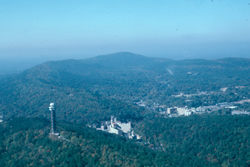 |
 | |
  | |
|
|
|
|
Hot Springs National Park
Nature & Science
|
|
|
|
|
| |
 |
 |
| This aerial photo shows how the park and city intertwine. |
 |
The hot springs are the primary natural resource of the park, but they have not been preserved in their unaltered state as natural surface phenomena. They have instead been managed to conserve the production of uncontaminated hot water for public use.
The mountains within the park are also managed within this conservation philosophy in order to preserve the hydrological system that feeds the springs. The park and its surrounding mountains exhibit a south-central United States pine-oak-hickory forest ecosystem. The park's vegetation, thermal waters, cold water springs, bathhouses and associated cultural features, foot trails, prehistoric and historic novaculite quarries, and general physiography combine to form an almost 5400 acre area of resource preservation and interpretation that is under the exclusive legislative jurisdiction of the federal government. Another 672.69 acres are within the park boundary but are not federally owned.
The city of Hot Springs, Arkansas, with an approximate population of 33,000, lies immediately outside the park and exerts a significant influence on it.
|
|  |  |
|
|

Relax on a shady park trail.
Get great trail information that was prepared by Hot Springs area EAST Lab students.
more... | |
|
|
|
|
|
|
|
 |
|
Did You Know?
The name Gulpha Creek is a corruption of the French name for the stream. Explorer William Dunbar reports the name "Fourche á Calfat" in the journal of his visit in 1804. Calfat eventually became Gulpha.
|
|
|
|
Last Updated: August 24, 2006 at 17:21 EST |






